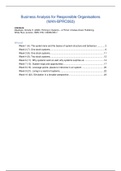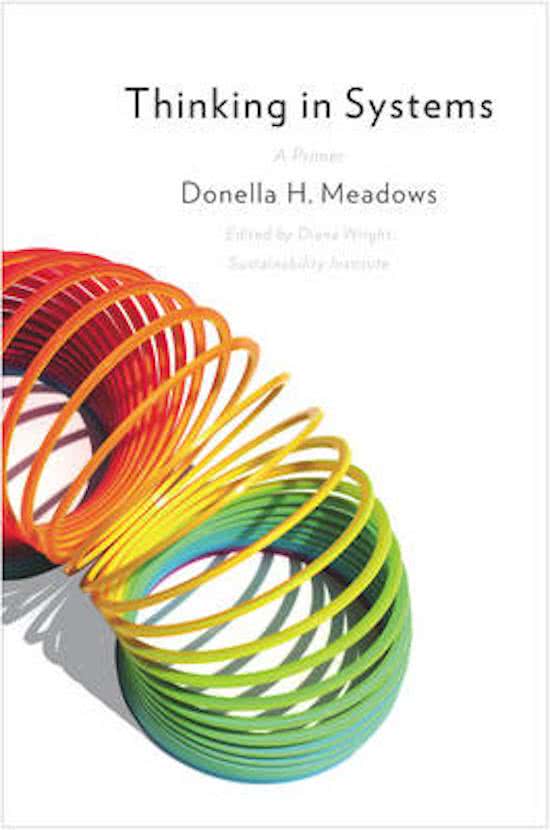Business Analysis for Responsible Organisations
(MAN-BPRO363)
Literature:
Meadows, Donella H. (2008) Thinking in Systems – A Primer. Chelsea Green Publishing,
White River Junction, ISBN: 978-1-60358-055-7
Inhoud
Week 1 (6). The system lens and the basics of system structure and behaviour ............. 2
Week 2 (7). One stock systems .......................................................................................... 6
Week 3 (8). One stock systems ........................................................................................ 11
Week 4 (9). Two stock systems ........................................................................................ 12
Week 6 (11). Why systems work so well; why systems surprise us ................................ 14
Week 7 (12). System traps and opportunities .................................................................. 17
Week 8 (16). Leverage points: places to intervene in an system .................................... 20
Week 9 (21). Living in a world of systems ........................................................................ 22
Week 10 (22). Simulation in a broader perspective ......................................................... 23
,Week 1 (6). The system lens and the basics of system structure and behaviour
→ Book Meadows Introduction + Chapter 1, p.1 - 34; Workbook A1
Lecture 1
A Systems Game, typically: performance increases then decreases as more balls (complexity) are
added. Players blame each other for performance. There is overlap with business management. Many
components to most business (functional areas). Interaction among them. Performance metrics and
goals with a time component.
A ‘System Lens’ can support decision making for ‘Responsible business organizations’. Analysis
from a systems perspective can improve decision making and outcomes.
What is a responsible business organization?
There is no definition. Associated terms are: socially responsible business, corporate social
responsibility and sustainable business. One common framework: triple bottom line (expands the
traditional accounting framework to include two other performance areas: the social and environmental
of their company).
A socially responsible business (SRB) is a generally for-profit venture that seeks to leverage
business for a more just and sustainable world. The objective of the SRBs involves more than just
maximizing profits for the shareholders; it is also about creating positive changes and making
valuable contributions to the stakeholders such as the local community, customers and staff.
What are the tools used to support decision making for businesses to be ‘responsible’?
Many tools exist. Two common tools: scorecards and standard (certifications, ISO). These tools are
useful, but have limitations: static (one point in time), may not always account for internal
organizational complexity, may not account for external stakeholders. Systems tools that account for
dynamics and complex interactions can provide additional insights and improve outcomes. Complexity
is not just internal to one organization, most operate in complex supply chains. Systems tools that
account for dynamics and complex interactions can provide additional insights and improve outcomes.
Why is a system approach needed?
Responsible organizations create multiple types of value simultaneously. Multiple value creation is
complex and requires a systemic understanding. System thinking and system dynamics are tools
that provide such understanding.
Introduction to a Systems Lens as a tool for Business Analysis for Responsible Organizations (BAfRO)
System = a set of elements or parts that is coherently organized and interconnected in a pattern or
structure that produces a characteristic set of behaviours, often classified as its function or purpose.
- Elements: are visible, often tangible, but not necessarily physical. The elements of systems
gradually change slowly if at all, but still stay the same system, as long as the interconnections
and purpose remains intact;
- Interconnections: the relationships that hold the elements together. If the interconnections
change, the system may be greatly altered even if the elements stay the same;
- Function or purpose: purposes are deducted from behaviour, not from rhetoric or stated goals. A
change in purpose/function changes the system profoundly even if the elements and
interconnections stay the same.
Connections and purpose often harder to identify than elements. Information connections often harder
to assess than physical flows. Purposes often not necessarily expressed explicitly. Deduce purpose by
observing how the system behaves over time. Look at behaviour, not rhetoric or stated goals.
A system lens needs more than words. Words and sentences come only one at a time in linear,
logical order. Systems happen all at once. They are connected not just in one direction, but in many
directions simultaneously. We need pictures, diagrams, graphs and models.
2
, Key system elements: stock and flows.
- Stocks are the foundation of any system. Stocks can be seen or measured at any given time. A
stock does not have to be physical. Stocks are always shown as boxes.
- Flows modify stocks. Flows can only be observed over time. A flow does not have to be physical.
Flows are shown as ‘valves’ and must be connected to stocks.
➔ Stocks change over time through the actions of one or more flows.
If you understand the dynamics of stocks and flows you understand a good deal about the behaviour
of complex systems. Changes in stocks set the pace of dynamics in systems, often we underestimate
time required for change. Stocks allow inflows and outflows to differ, inventories mean production does
not need to equal consumption. Several important principles:
- Sum of inflows > sum of outflows → stock will increase;
- Sum of inflows < sum of outflows → stock will decrease;
- Sum of inflows = sum of outflows → stock will be constant;
- Dynamic equilibrium: the condition in which the state of a stock is steady and unchanging,
despite inflows and outflows.
Feedback connects stock and flows, also influencing system behaviour over time. Often, flow rates are
linked to the value of the stock. Flows depend on stocks and stocks depend on flows → this is
feedback. A feedback loop is a closed chain of causal connections from a stock, through a set of
decisions or rule or physical laws or actions that are dependent on the level of the stock and back
again through a flow to change the stock.
- Reinforcing feedback/runaway loop: an amplifying or enhancing feedback loop, also known as
the positive feedback loop because it reinforces the direction of change. It generates more input to
a stock the more that is already there and enhances whatever direction of change is imposed on
it;
- Balancing feedback loop: a stabilizing, goal seeking, regulating feedback loop known as a
negative feedback loop because it opposes, or reverses, whatever direction of change is imposed
by the system. Opposes whatever direction of change is imposed on the system. If you push a
stock too far up, a balancing loop will try to pull it back down. If you shove it too far down, a
balancing loop will try to bring it back up.
3







